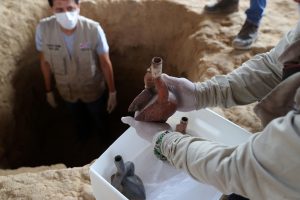
Tucume, Peru, Jul 5 (EFE).- A set of as many as 24 royal tombs was discovered in Peru’s majestic Valley of the Pyramids, shining a new light on the largest empire in the pre-Columbian Americas.
The finding – which was presented on Wednesday by a group of archaeologists with the country’s Ministry of Culture – confirms the value that the Incas placed on the Tucume pyramids, which are part of Peru’s largest architectural complex of its kind.
“We have evidence that this is an elite group, comprised by both men and women,” Bernarda Delgado, director of the Tucume museum, told EFE, adding that the individuals were buried wrapped in fine garments and next to an assortment of ceramic utensils, which were not familiar to the common folk.
The collection of 26 pyramids – among which is the tallest in all of South America – may seem to the untrained eye as nothing more than a few sandy hills spread throughout the 221-hectare (540-acre) surface.
However, underneath the mounds hide several pyramids built some thousand years ago – centuries before the Incas arrived in the land around 1470 – using mud bricks instead of stones.
Both the Incas and the mysterious culture behind the edifices gave the complex a ceremonial role, which is evinced by the Inca tombs discovered by Executing Unit 005 Naylamp in the Las Abejas temple, one of the structures that comprise the compound.
With 89 people working on site and a government grant of 8.3 million soles (about $2.5 million), the archaeologists hope to find more Inca burials in the site.
